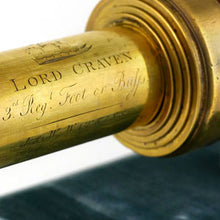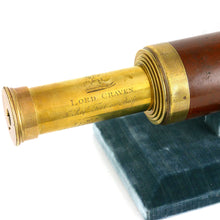The Buffs, 3rd Regiment of Foot - Lord Craven’s Telescope, 1794-95
Adding product to your cart
Length closed: 30cm (12in)
Brass and mahogany. Five draw refracting telescope, signed by the maker J. & W. Watkins of Charing Cross, London. The brass tube engraved with a baron’s coronet over the Craven family crest (On a Chapeau Gules turned up Ermine a Griffin statant wings elevated Ermine beaked and foremembered Or), and inscribed ‘Lord Craven / 3rd Regt Foot or Buffs’. Extended length: 105cm (40.25in).
Read more
Lord Craven is probably best remembered today from the opening lines of Harriette Wilson’s memoir - ‘I shall not say why and how I became, at the age of fifteen, the mistress of the Earl of Craven.’ To the mind of the 19th century military historian Richard Cannon he was in 1794 a ‘gallant young nobleman in his twenty-fourth year’, in command of The Buffs on campaign in the Low Countries against Revolutionary France’s Army of the North during the harsh winter of 1794-95. However, from snippets gleaned from regimental history and the musings of Jane Austen, who is said to have based ‘Sense and Sensibility’s villainous Mr Willougihby on Lord Craven, it is unlikely he shared the hardships suffered by his men. It is noted a number of senior officers who were also Members of Parliament slipped back to London, as might any with a seat in the House of Lords. Of the those that did remain with the ill-equipped, typhus scourged army, it is further noted that during the ignominious retreat into Germany in January 1795 many officers sped by the struggling columns in their carriages. Lord Craven continued in command of the Buffs following their evacuation to England and during their subsequent deployment to the West Indies. As a future founding member of the Royal Yacht Squadron (est.1815), Craven accompanied the troop convoy in a private yacht.
William Craven, 7th Baron Craven, later 1st Earl of Craven, (1770-1825) was the eldest son of William, 6th Baron Craven and strong-willed Lady Elizabeth Berkeley. His parents were ill-suited and following his father’s death in 1791 his mother married Charles Alexander, the last Margrave of Brandenburg-Ansbach. Lord Craven was educated at Eton and at sixteen was commissioned into the Berkshire Militia. In 1793 he joined the 43rd Foot as an ensign. Within the space of year he purchased a majority in the 80th Regiment, a lieutenant-colonelcy in the 84th Regiment and succeeded Lord Newark in September 1794 to command to the 3rd Foot, The Buffs. In the 1660s the regiment was deployed in Protestant Dutch service against Habsburg Spain in the Low Countries and was named for his ancestor Lord Craven’s Regiment. The 7th Lord Craven was destined to fight over the same ground in 1794-95.

Several social and familial connections have been made between Craven and Jane Austen, not least of which was her sister Cassandra’s engagement to Craven’s cousin the Rev. Tom Craven Fowle. Fowle hoped to be given a parish in Shropshire under Craven’s patronage that would provide him with the income support a wife. Accordingly Fowle agreed to serve as Craven’s private chaplain on the 1796 expedition the West Indies. To the lasting grief of Cassandra Austen, Fowle died of yellow fever in San Domingo later that year. Craven afterwards told the Austens, that had he known of the engagement he would never have allowed Fowle to serve in so perilous a post. Craven himself did not linger long in the W. Indies and by June 1796 was ‘on leave’. In 1798 he was promoted Colonel of the Buffs and Aide-de-Camp to George III. The next year he appears to have been in command of the 40th Foot. In 1801 he was created 1st Viscount Uffington and the same year 1st Earl of Craven. He was a firm friend of the Prince Regent and in 1805 appeared in a barouche driven by the Prince himself at Brighton races. He was promoted to Major-General in 1805; Lieutenant-General in 1811; and General in 1825, the year he died.
The Watkins optical business at 5 Charing Cross, London was begun in 1747 by Francis Watkins. Watkins retired in 1784 and passed his Charing Cross business to his nephews Jeremiah and Walter. It later passed to Jeremiah's son, Francis Jr., in circa 1798 who partnered with his father's foreman, William Hill, as Watkins & Hill, (fl. 1818-1856).
Sources:
Cannon, R. (1837), Historical Records of the British Army- the Third Regiment of Foot; or, the Buffs
Knight, Capt. C.R.B.(1935), ‘Historical Records of The Buffs, East Kent Regiment (3rd Foot), 1704-19104
Lanfersieck, L. & Looser, D., 'Austen’s Sense and Sensibility and Lord Craven’, Notes and Queries, 2009-09, Vol.56 (3), p.376-381, Oxford University Press












